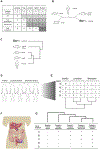PhyloOncology: Understanding cancer through phylogenetic analysis
- PMID: 27810337
- PMCID: PMC9583457
- DOI: 10.1016/j.bbcan.2016.10.006
PhyloOncology: Understanding cancer through phylogenetic analysis
Abstract
Despite decades of research and an enormity of resultant data, cancer remains a significant public health problem. New tools and fresh perspectives are needed to obtain fundamental insights, to develop better prognostic and predictive tools, and to identify improved therapeutic interventions. With increasingly common genome-scale data, one suite of algorithms and concepts with potential to shed light on cancer biology is phylogenetics, a scientific discipline used in diverse fields. From grouping subsets of cancer samples to tracing subclonal evolution during cancer progression and metastasis, the use of phylogenetics is a powerful systems biology approach. Well-developed phylogenetic applications provide fast, robust approaches to analyze high-dimensional, heterogeneous cancer data sets. This article is part of a Special Issue entitled: Evolutionary principles - heterogeneity in cancer?, edited by Dr. Robert A. Gatenby.
Keywords: Cancer stratification; Cancer types; Clonal evolution; Tumor heterogeneity; Tumor trees.
Copyright © 2016 Elsevier B.V. All rights reserved.
Figures


References
Publication types
MeSH terms
Substances
Grants and funding
LinkOut - more resources
Full Text Sources
Other Literature Sources

